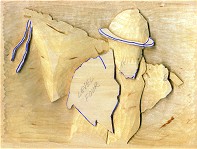Wood Carving and Wood Burning
By L. S. Irish


I made one of the most common blunders that any carver or craftsman can make, I didn’t think ahead. In this particular case I can say that quite literally as I will explain.
Our family is sitting in the living room, huddled around the TV for the latest news and I needed something to do. So, I grabbed a copy of American Heroes and decided I would carve. Not wanting to wait till morning to go to the shop and properly prepare a large basswood board (and not wanting to leave the TV set for fear I would miss something) I grabbed a pre-made 3/4″ thick, 6″ x 8″ basswood blank that I had thrown into my carving tool kit. (OOPS!) I was well into the work before I realized what I type of commitment I had made, a head the size of a postage stamp.
Since I am a true believer that we often learn more from our mistakes than from our successes, I am going to use the piece as a teaching project, flaws and all!
Next time, I will plan a head … That is a head that is at least 2″ x 2″ to provide a nice wide space for working!

ESTABLISHING THE LAYERS
Begin this design by breaking the pattern into layers of carving work. I have chosen five levels total, counting the background as one of the levels.
The first level from the background contains the flag, iron rod, and the Fireman’s arm. Level two is his shirt and belly area. The next layer up will be the face and the bowl of the hat. This makes the final level, or highest area of the carving, the flag over his shoulder and the hat brim.
By breaking a pattern down into levels you are able to establish the general depth of an area before the detail carving is added. This both speeds up the carving process and eliminates guessing over the depth of any individual item in the pattern.
Using carbon paper trace just the outline areas of each level to your blank. Mark each area with a pencil as to it’s respective level.

ROUGHING OUT THE BACKGROUND
Throughout the work I am using a small Chip Knife as my bench knife and a set of Long Handled Japanese Carving Tools. I also have on the work bench my sharpening stones, strop, and some fine grit sandpaper.
With a wide round chisel begin dropping the background area. Taper the work from the sides of the blank into the depths along the main design. Since I am working on a 3/4″ thick board my deepest area is about 3/8″ from the original surface.
On any carving I try to keep the deepest areas at one half the thickness of the board. This helps to reduce cupping and warping after the carving is completed.

LEVEL ONE
Working from the farthest point in the carving to the highest point. Begin by rouging in the main shape and depth of Level One. Note in the image to the left that an area within the flag has been left proud as has the far side of the Fireman’s hand. Use a Stop Cut along the outline edge then taper the area of Level One where it comes into contact with the body deeply.
Proud: to leave an area higher than it’s surrounding area or at the original level of the wood.
I am using both the wide round gouge and the large bull nose chisel for this work.

LEVEL TWO
The shirt and belly area become our second level. It lies in front of the flag and hand but behind the shoulder and face. Round this area over so that he literally bellies out along the center area of the shirt.
LEVEL THREE
The next level is Level Three and contains the face and the bowl of the hat. Note that at the bottom of the face, covering the Fireman’s mouth and chin will be his dust mask. This area is left un-worked as it will end up higher on the carving.
LEVEL FOUR
The final level includes the flag over his shoulder and the hat brim. At this time I leave these areas at the original wood surface. They will receive just a small amount of rounding over during the detailing work.

